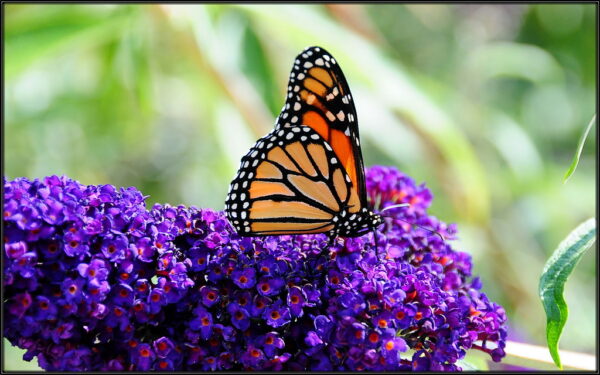Butterflies are a group of insects belonging to the order Lepidoptera, which also includes moths. They are characterized by their large, often brightly colored wings and fluttering flight. Butterflies have scales covering their wings and come in a variety of colors and sizes.
Scientific Name
The scientific name for butterflies is Rhopalocera.
Physical Traits
Butterflies have two pairs of wings covered with tiny scales that give them color and pattern. The size of butterflies can range from 1/2 inch to 12 inches across, depending on the species. They also have antennae, compound eyes, and long proboscis (tongue) used for feeding on nectar from flowers.
Life Span
The life span of butterflies varies greatly depending on the species, but most live for only a few weeks or months. Some species may live up to 9 months in total.
Habitat
Butterflies inhabit almost every terrestrial habitat on earth except Antarctica and some remote islands. They can be found in forests, grasslands, deserts, wetlands, mountains, meadows, gardens, parks, and even urban areas.
Diet
Most adult butterflies feed on nectar from flowers while some feed on rotting fruit or tree sap. The larvae (caterpillars) of many species feed on leaves or other plant material while others feed on aphids or other small insects.
Reproduction
Butterflies reproduce sexually through internal fertilization by males depositing sperm into females during mating rituals. Females lay eggs singly or in clusters depending on the species and these eggs hatch into caterpillars which then pupate into adults after several weeks or months depending on the species and environmental conditions such as temperature and humidity levels.
Conservation Status
Many butterfly species are threatened due to habitat loss caused by human activities such as deforestation and urban development as well as climate change resulting in extreme weather events such as droughts or floods that can affect their populations drastically over time if not addressed properly with conservation efforts aimed at preserving their habitats from destruction or degradation by humans.
Interesting Facts
- Butterflies taste with their feet! They have taste receptors located at the tips of their legs which allow them to detect food sources when they land on them before feeding off them with their proboscis (tongue).
- Butterflies use pheromones to communicate with each other during courtship rituals where males release these chemicals into the air to attract potential mates from far away distances!
- Some butterfly species migrate great distances annually between summer breeding grounds in northern regions to winter hibernation sites in warmer climates further south!
Sources:
- https://www.si.edu/spotlight/buginfo/butterfly
- https://en.wikipedia.org/wiki/Butterfly
- https://www.britannica.com/animal/butterfly-insect
Six Common Families of Butterflies
Butterflies are one of the most beloved insects in the world, and there are six common families that can be found in a variety of habitats around the globe. From the large and colorful Swallowtails to the small and fast-flying Skippers, each family has its own unique characteristics that make them stand out from the rest.
Swallowtails (Family Papilionidae)
Swallowtails are the most recognizable of all butterfly families due to their large size and colorful wings. They can be found in a variety of habitats around the world, including meadows, forests, fields, gardens, and even urban areas. The wingspan of these butterflies ranges from 2-6 inches (5-15 cm), with some species having wings as large as 8 inches (20 cm). The colors on their wings vary greatly depending on the species but often include yellow, orange, black, blue, white, and brown.
Whites and Sulphurs (Family Pieridae)
Whites and Sulphurs are also quite common butterflies with many species having white or yellow wings with black markings. These butterflies typically have a wingspan between 1-3 inches (2.5-7 cm), making them slightly smaller than Swallowtails. They can be found in open grasslands or meadows where they feed on nectar from flowers such as daisies or clover.
Hairstreaks and Blues (Family Lycaenidae)
Hairstreaks and Blues are smaller than other butterfly families but have beautiful iridescent blue or purple wings that shimmer in the sunlight. These butterflies typically have a wingspan between 0.5-1 inch (1-2 cm), making them much smaller than Swallowtails or Whites/Sulphurs. They can be found in wooded areas where they feed on flower nectar or tree sap.
Metalmarks (Family Riodinidae)
Metalmarks are small butterflies that have metallic-looking scales on their wings which give them an almost metallic sheen when viewed up close. These butterflies typically have a wingspan between 0.75 – 1 inch (2 – 2.5 cm), making them slightly larger than Hairstreaks/Blues but still much smaller than other butterfly families. They can be found near streams or rivers where they feed on flower nectar or tree sap.
Nymphalids (Family Nymphalidae)
Nymphalids are some of the most diverse butterflies in terms of coloration and patterning, with many species having bright orange or red wings with black spots or stripes along the edges. These butterflies typically have a wingspan between 1 – 3 inches (2 – 7 cm), making them slightly larger than Metalmarks but still much smaller than other butterfly families like Swallowtails or Whites/Sulphurs. They can be found near ponds or lakes where they feed on flower nectar or tree sap during the day before returning to roost at night among foliage near water sources such as streams or rivers.
Skippers (Family Hesperiidae)
Skippers are small, fast-flying butterflies that often have a more angular shape than other butterfly families due to their short antennae and stout bodies which help them maneuver quickly through air currents while hunting for food sources such as flower nectar or tree sap during daylight hours before returning to roost at night among foliage near water sources such as streams or rivers. These butterflies typically have a wingspan between 0 . 5 – 1 inch (1 – 2 cm ), making them much smaller than other butterfly families like Swallowtails, Whites / Sulphurs, Metalmarks, or Nymphalids.

